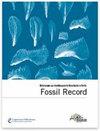下载PDF
{"title":"Character distribution and phylogeny of the dissorophid temnospondyls","authors":"Rainer R. Schoch","doi":"10.1002/mmng.201200010","DOIUrl":null,"url":null,"abstract":"<p>The phylogeny of the largely Permian temnospondyl group Dissorophidae is analyzed for the first time. Although hampered by poor preservation and incompleteness of finds, new data add substantially to our knowledge of the group. An analysis of 25 taxa and 70 characters gave the following results. (1) The Dissorophidae and Trematopidae each form monophyletic groups that are more closely related to one another than either of them is to amphibamids. Olsoniformes and Amphibamidae are each defined by clear-cut autapomorphies, making it unlikely that amphibamids are dwarfed dissorophids or olsoniforms. (2) <i>Ecolsonia</i> nests with <i>Fedexia</i> at the base of the Trematopidae. (3) The Dissorophidae falls into two major clades, the Dissorophinae sensu stricto (<i>Dissorophus</i>, <i>Broiliellus</i>) and the Cacopinae (<i>Cacops</i>, <i>Kamacops</i>, <i>Zygosaurus</i>). The Cacopinae is much better supported than the Dissorophinae. <i>Platyhystrix</i> and <i>Aspidosaurus</i> form successive sister taxa of all other dissorophids. Incompletely known dissorophids were found to nest as follows: (a) <i>Brevidorsum</i>, the Admiral Taxon and Rio Arriba Taxon at the base of the Cacopinae and (b) <i>Conjunctio multidens</i> forms an unresolved trichotomy with dissorophines and cacopines. The significance of osteoderms in dissorophid phylogeny is found to be much smaller than hitherto considered. (© 2012 WILEY-VCH Verlag GmbH & Co. KGaA, Weinheim)</p>","PeriodicalId":55147,"journal":{"name":"Fossil Record","volume":"15 2","pages":"121-137"},"PeriodicalIF":1.4000,"publicationDate":"2012-08-03","publicationTypes":"Journal Article","fieldsOfStudy":null,"isOpenAccess":false,"openAccessPdf":"https://sci-hub-pdf.com/10.1002/mmng.201200010","citationCount":"32","resultStr":null,"platform":"Semanticscholar","paperid":null,"PeriodicalName":"Fossil Record","FirstCategoryId":"89","ListUrlMain":"https://onlinelibrary.wiley.com/doi/10.1002/mmng.201200010","RegionNum":4,"RegionCategory":"地球科学","ArticlePicture":[],"TitleCN":null,"AbstractTextCN":null,"PMCID":null,"EPubDate":"","PubModel":"","JCR":"Q3","JCRName":"Earth and Planetary Sciences","Score":null,"Total":0}
引用次数: 32
引用
批量引用
Abstract
The phylogeny of the largely Permian temnospondyl group Dissorophidae is analyzed for the first time. Although hampered by poor preservation and incompleteness of finds, new data add substantially to our knowledge of the group. An analysis of 25 taxa and 70 characters gave the following results. (1) The Dissorophidae and Trematopidae each form monophyletic groups that are more closely related to one another than either of them is to amphibamids. Olsoniformes and Amphibamidae are each defined by clear-cut autapomorphies, making it unlikely that amphibamids are dwarfed dissorophids or olsoniforms. (2) Ecolsonia nests with Fedexia at the base of the Trematopidae. (3) The Dissorophidae falls into two major clades, the Dissorophinae sensu stricto (Dissorophus , Broiliellus ) and the Cacopinae (Cacops , Kamacops , Zygosaurus ). The Cacopinae is much better supported than the Dissorophinae. Platyhystrix and Aspidosaurus form successive sister taxa of all other dissorophids. Incompletely known dissorophids were found to nest as follows: (a) Brevidorsum , the Admiral Taxon and Rio Arriba Taxon at the base of the Cacopinae and (b) Conjunctio multidens forms an unresolved trichotomy with dissorophines and cacopines. The significance of osteoderms in dissorophid phylogeny is found to be much smaller than hitherto considered. (© 2012 WILEY-VCH Verlag GmbH & Co. KGaA, Weinheim)
失sorophili temnospondyls的特征、分布和系统发育
本文首次分析了二叠纪蝶螺科的系统发育。尽管受到保存不善和发现不完整的阻碍,新的数据大大增加了我们对这个群体的了解。对25个分类群和70个性状的分析结果如下:(1)水蛭科和水蛭科都是单系类群,彼此之间的亲缘关系比它们与两栖类的亲缘关系更密切。双足类和两栖类都有明确的自异形特征,这使得两栖类不太可能是矮小的异足类或两栖类。(2)在吸虫科基部有蚁巢。(3)棘龙科分为两大支系,即狭义棘龙支系(棘龙支系)和棘龙支系(棘龙支系)。Cacopinae比Dissorophinae有更好的支撑。桔梗龙和穗状龙是所有其他异源类的连续姐妹类群。发现不完全已知的异索虫筑巢如下:(a) Brevidorsum, Admiral分类群和Rio Arriba分类群在Cacopinae的底部;(b) Conjunctio multidens与异索虫和cacopines形成一个未确定的三分形。骨皮细胞在失sorhid系统发育中的重要性被发现比迄今认为的要小得多。(©2012 WILEY-VCH Verlag GmbH &KGaA公司,Weinheim)
本文章由计算机程序翻译,如有差异,请以英文原文为准。


